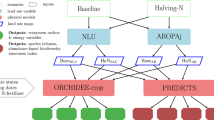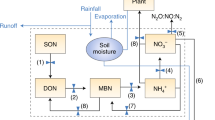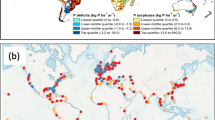Abstract
Mineral nitrogen (N) application in agriculture has significantly increased food production over the past century. However, the intensive use of N fertilizers also impacts negatively the environment, notably through greenhouse gas emissions and biodiversity loss and remains a major challenge for policymakers. In this paper, we explore the effects of a public policy aiming at halving agricultural mineral nitrogen use across the European Union (EU). We investigate the impacts on food security, climate mitigation, and biodiversity conservation and we analyze the potential trade-offs and synergies between them. Despite the uncertainties associated with monetary valuation and the choice of modeling approach, our results show that climate- and biodiversity-related benefits of halving N use in EU agriculture more than offset the decrease in agricultural benefits.



Similar content being viewed by others
Availability of data and material
Available on request
Code availability
Not applicable
Notes
According to FAO (1996): “Food security exists when all people, at all times, have physical and economic access to sufficient, safe and nutritious food that meets their dietary needs and food preferences for an active and healthy life”. Because of lack of data and our modeling framework, we restrict in this paper food security to only one dimension namely “agricultural production” in the EU. This is a restrictive vision of food security which assumes that access, stability and quality are not an issue in the EU, and that food loss and waste are limited.
In this paper, “Climate change mitigation” takes into account both non-CO\(_{2}\) greenhouse gas emission (N\(_{2}\)O and CH\(_{4}\)) reductions and carbon sequestration.
This paper presents the synthesis of results of the STIMUL (Scenarios Towards Integrating MUlti-scale Land-use tools) project. For more information see https://sites.google.com/view/stimul-project/
For a given quantity of agricultural product, farmers have to combine land and inputs. The amounts of these factors of production are supposedly decided in a rational way where the objective is to reduce costs. If input prices increase (via a tax, for instance), farmers should cultivate a greater area of land in order to attain the same level of production. Thus the reduction in input (the intensive margin of agriculture) could lead to an increase in land cultivated (the extensive margin of agriculture).
The differences between the two models are exaggerated by the recalculation of land use acreage by the econometric land use model and the extrapolation of AROPAj values (see Section “Links between models”). Without the econometric land use model, cropland and pastures represent 124 million ha, the N mineral use is practically the same as in NLU and the total crop production is 338 million tDM/yr.
References
Barreiro-Hurle, J., Bogonos, M., Himics, M., Hristov, J., Pérez-Domínguez, I., Sahoo, A., Salputra, G., Weiss, F., Baldoni, E., & Elleby, C. (2021). Modelling transitions to sustainable food systems: Are we missing the point? EuroChoices, 20(3), 12–20. https://doi.org/10.1111/1746-692X.12339
Bayramoglu, B., Chakir, R., & Lungarska, A. (2020). Impacts of land use and climate change on freshwater ecosystems in France. Environmental Modeling & Assessment, 25(2), 147–172.
Beckman, J., Ivanic, M., Jelliffe, J. L., Baquedano, F. G., & Scott, S. G. (2020). Economic and food security impacts of agricultural input reduction under the European Union Green Deal’s farm to fork and biodiversity strategies. Economic Brief 30, United States Department of Agriculture.
Bellora, C. & Bureau, J.-C. (2013). The indirect trade and virtual land effects of a greener eu agriculture. working paper presented at AIEAA Conference, June 6-7 2013, Parma.
Billen, G., Garnier, J., & Lassaletta, L. (2013). The nitrogen cascade from agricultural soils to the sea: Modelling nitrogen transfers at regional watershed and global scales. Philosophical Transactions of the Royal Society B: Biological Sciences, 368(1621), 20130123.
Bondeau, A., Smith, P. C., Zaehle, S., Schaphoff, S., Lucht, W., Cramer, W., Gerten, D., Lotze-Campen, H., Müller, C., Reichstein, M., & Smith, B. (2007). Modelling the role of agriculture for the 20th century global terrestrial carbon balance. Global Change Biology, 13(3), 679–706. https://doi.org/10.1111/j.1365-2486.2006.01305.x
Bremmer, J., Gonzalez Martinez, A., Jongeneel, R., Huiting, H., & Stokkers, R. (2021). Impact assessment study on ec 2030 Green Deal targets for sustainable food production: Effects of farm to fork and biodiversity strategy 2030 at farm, national and eu level.
Brink, C., van Grinsven, H., Jacobsen, B. H., Rabl, A., Gren, I.-M., Holland, M., Klimont, Z., Hicks, K., Brouwer, R., Dickens, R., Willems, J., Termansen, M., Velthof, G., Alkemade, R., van Oorschot, M., & Webb, J. (2011). Costs and benefits of nitrogen in the environment. In A. Bleeker, B. Grizzetti, C. M. Howard, G. Billen, H. van Grinsven, J. W. Erisman, M. A. Sutton, & P. Grennfelt (Eds.), The European nitrogen assessment: Sources, effects and policy perspectives. Cambridge University Press.
Brisson, N., Gary, C., Justes, E., Roche, R., Mary, B., Ripoche, D., Zimmer, D., Sierra, J., Bertuzzi, P., Burger, P., Bussière, F., Cabidoche, Y., Cellier, P., Debaeke, P., Gaudillère, J., Hénault, C., Maraux, F., Seguin, B., & Sinoquet, H. (2003). An overview of the crop model stics. European Journal of Agronomy, 18(3–4), 309–332. https://doi.org/10.1016/S1161-0301(02)00110-7
Brisson, N., Launay, M., Mary, B., & Beaudoin, N. (2009). Conceptual basis. QUAE: Formalisations and parameterization of the stics crop model.
Brunelle, T., Dumas, P., Aoun, W. B., & Gabrielle, B. (2018). Unravelling land-use change mechanisms at global and regional scales. BioPhysical Economics and Resource Quality, 3(3), 13.
Brunelle, T., Dumas, P., Souty, F., Dorin, B., & Nadaud, F. (2015). Evaluating the impact of rising fertilizer prices on crop yields. Agricultural Economics, 46(5), 653–666. https://doi.org/10.1111/agec.12161
Burkhard, B., Santos-Martin, F., Nedkov, S., & Maes, J. (2018). An operational framework for integrated mapping and assessment of ecosystems and their services (Maes). One Ecosystem, 3, e22831. https://doi.org/10.3897/oneeco.3.e22831.
Chakir, R. & Le Gallo, J. (2021). Spatial autocorrelation in econometric land use models: An overview. A. Daouia & A. Ruiz-Gazen (Eds.) Advances in contemporary statistics and econometrics, (pp. 339–362). Springer.
Chakir, R., & Lungarska, A. (2017). Agricultural rent in land-use models: Comparison of frequently used proxies. Spatial Economic Analysis, 1–25. https://doi.org/10.1080/17421772.2017.1273542
Chang, J., Havlík, P., Leclère, D., de Vries, W., Valin, H., Deppermann, A., Hasegawa, T., & Obersteiner, M. (2021). Reconciling regional nitrogen boundaries with global food security. Nature Food, 2(9), 700–711.
Council of the European Communities (1991). Council Directive 91/676/EEC of 12 December 1991 concerning the protection of waters against pollution caused by nitrates from agricultural sources.
Devaraju, N., Prudhomme, R., Lungarska, A., Wang, X., Yin, Z., de Noblet-Decoudr, N., Chakir, R., Jayet, P.-A., Brunelle, T., Viovy, N., Palma, A. D., Gonzalez, R., & Ciais, P. (2022). How reducing synthetic nitrogen in Europe affects ecosystem carbon and biodiversity: Two perspectives of the same policy. Working Paper. https://hal.inrae.fr/hal-03763653v1
Dietz, S. and Neumayer, E. (2007). Weak and strong sustainability in the SEEA: Concepts and measurement. Ecological Economics, 61(4), 617–626.
Dise, N., Ashmore, M., Belyazid, S., Bleeker, A., Bobbink, R., De-Vries, W., Erisman, J., Spranger, T., Stevens, C., & Van Den Berg, L. (2011). Nitrogen as a threat to European terrestrial biodiversity. The European nitrogen assessment sources, effects and policy perspectives.
Ekins, P., Simon, S., Deutsch, L., Folke, C., & De Groot, R. (2003). A framework for the practical application of the concepts of critical natural capital and strong sustainability. Ecological Economics, 44(2-3), 165–185.
Erisman, J. W., Sutton, M. A., Galloway, J., Klimont, Z., & Winiwarter, W. (2008). How a century of ammonia synthesis changed the world. Nature Geoscience, 1, 636.
Eurostat (2018). Agri-environmental indicator—gross nitrogen balance.
FAO (1996). World food summit: Rome declaration on world food security and World Food summit plan of action. FAO.
Foley, J. A. (2005). Global consequences of land use. Science, 309(5734), 570–574. https://doi.org/10.1126/science.1111772
Friedlingstein, P., Joel, G., Field, C. B., & Fung, I. Y. (1999). Toward an allocation scheme for global terrestrial carbon models. Global Change Biology, 5, 755–770. https://doi.org/10.1046/j.1365-2486.1999.00269.x
Gutés, M. C. (1996). The concept of weak sustainability. Ecological Economics, 17(3), 147–156.
Hager, T. (2009). The alchemy of air: A Jewish genius, a doomed tycoon, and the scientific discovery that fed the world but fueled the rise of Hitler. Broadway Books.
Hill, S. L., Gonzalez, R., Sanchez-Ortiz, K., Caton, E., Espinoza, F., Newbold, T., Tylianakis, J., Scharlemann, J. P., De Palma, A., & Purvis, A. (2018). Worldwide impacts of past and projected future land-use change on local species richness and the biodiversity intactness index. bioRxiv, pp. 311787.
Hudson, L. N., Newbold, T., Contu, S., Hill, S. L., Lysenko, I., De Palma, A., Phillips, H. R., Alhusseini, T. I., Bedford, F. E., Bennett, D. J., et al. (2017). The database of the predicts (projecting responses of ecological diversity in changing terrestrial systems) project. Ecology and Evolution, 7(1), 145–188.
Humblot, P., Jayet, P.-A., & Petsakos, A. (2017). Farm-level bio-economic modeling of water and nitrogen use: Calibrating yield response functions with limited data. Agricultural Systems, 151, 47–60. https://doi.org/10.1016/j.agsy.2016.11.006
Hurtt, G. C., Chini, L. P., Frolking, S., Betts, R., Feddema, J., Fischer, G., Fisk, J., Hibbard, K., Houghton, R., Janetos, A., et al. (2011). Harmonization of land-use scenarios for the period 1500–2100: 600 years of global gridded annual land-use transitions, wood harvest, and resulting secondary lands. Climatic Change, 109(1–2), 117.
Intergovernmental Science-Policy Platform on Biodiversity and Ecosystem Services, IPBES. (2018). The IPBES regional assessment report on biodiversity and ecosystem services for Europe and Central Asia.
IPCC (2013). Climate Change 2013: The physical science basis. Contribution of Working Group I to the Fifth Assessment Report of the Intergovernmental Panel on Climate Change. Cambridge University Press, Cambridge, United Kingdom and New York, NY, USA.
Jayet, P.-A., Petsakos, A., Chakir, R., Lungarska, A., De Cara, S., Petel, E., Humblot, P., Godard, C., Leclère, D., Cantelaube, P., Bourgeois, C., Clodic, M., Bamière, L., Ben Fradj, N., Aghajanzadeh-Darzi, P., Dumollard, G., Isbăşoiu, A., Adrian, J., Pilchak, G., Bounaffaa, M., Barberis, D., Assaiante, C., Ollier, M., Henry, L., & Florio, A. (2018). The European agro-economic AROPAj model. INRA, UMR Economie Publique, Thiverval-Grignon, https://www6.versailles-grignon.inra.fr/economie_publique_eng/Research-work. Accessed Aug 2022
Kanter, D. R., Wagner-Riddle, C., Groffman, P. M., Davidson, E. A., Galloway, J. N., Gourevitch, J. D., van Grinsven, H. J., Houlton, B. Z., Keeler, B. L., Ogle, S. M., et al. (2021). Improving the social cost of nitrous oxide. Nature Climate Change, 11(12), 1008–1010.
Lungarska, A., Brunelle, T., Chakir, R., Jayet, P.-A., Prudhomme, R., de Cara, S., & Bureau, J.-C. (2022). Halving mineral nitrogen use in European agriculture: Insights from multi-scale land-use models. Working Paper. https://hal.inrae.fr/hal-03761774
Lungarska, A., & Chakir, R. (2018). Climate-induced land use change in France: Impacts of agricultural adaptation and climate change mitigation. Ecological Economics, 147, 134–154. https://doi.org/10.1016/j.ecolecon.2017.12.030
Lungarska, A., Chakir, R., & Jayet, P.-A. (2018). Input taxation at different spatial scales: Reducing nitrogen fertilizer use in Europe. 6th world congress of environmental and resource economists, (WCERE), 2018, Gothenburg.
Lungarska, A., & Jayet, P.-A. (2018). Impact of spatial differentiation of nitrogen taxes on French farms’ compliance costs. Environmental and Resource Economics, 69(1), 1–21. https://doi.org/10.1007/s10640-016-0064-9
Neumayer, E. (2003). Weak versus strong sustainability: Exploring the limits of two opposing paradigms. Edward Elgar Publishing.
Nordhaus, W. (2014). Estimates of the social cost of carbon: Concepts and results from the DICE-2013R model and alternative approaches. Journal of the Association of Environmental and Resource Economists, 1(1/2), 273–312. https://doi.org/10.1086/676035
Obersteiner, M., Walsh, B., Frank, S., Havlík, P., Cantele, M., Liu, J., Palazzo, A., Herrero, M., Lu, Y., Mosnier, A., et al. (2016). Assessing the land resource-food price nexus of the sustainable development goals. Science Advances, 2(9), e1501499.
Prudhomme, R., Brunelle, T., Dumas, P., Le Moing, A., & Zhang, X. (2020). Assessing the impact of increased legume production in Europe on global agricultural emissions. Regional Environmental Change, 20(3), 91. https://doi.org/10.1007/s10113-020-01651-4
Prudhomme, R., De Palma, A., Dumas, P., Gonzalez, R., Leadley, P., Levrel, H., Purvis, A., & Brunelle, T. (2020). Combining mitigation strategies to increase co-benefits for biodiversity and food security. Environmental Research Letters, 15(11), 114005.
Purvis, A., Newbold, T., De Palma, A., Contu, S., Hill, S. L., Sanchez-Ortiz, K., Phillips, H. R., Hudson, L. N., Lysenko, I., Börger, L., et al. (2018). Modelling and projecting the response of local terrestrial biodiversity worldwide to land use and related pressures: The predicts project. In Advances in Ecological Research, vol. 58, (pp. 201–241). Elsevier
Pörtner, H. O., Scholes, R. J., Agard, J., Archer, E., Arneth, A., Bai, X., Barnes, D., Burrows, M., Chan, L., & Cheung, W. L. (2021). IPBES-IPCC co-sponsored workshop report on biodiversity and climate change. Intergovernmental Science-Policy Platform on Biodiversity and Ecosystem: Publisher.
Ramankutty, N., Evan, A. T., Monfreda, C., & Foley, J. A. (2008). Farming the planet: 1. geographic distribution of global agricultural lands in the year 2000. Global Biogeochemical Cycles, 22. https://doi.org/10.1029/2007GB002952.
Robinson, T. P., Wint, G. W., Conchedda, G., Van Boeckel, T. P., Ercoli, V., Palamara, E., et al. (2014). Mapping the global distribution of livestock. PloS One, 9(5).
Rockström, J., Steffen, W., Noone, K., Persson, Å., Chapin, F. S., III., Lambin, E. F., Lenton, T. M., Scheffer, M., Folke, C., Schellnhuber, H. J., Nykvist, B., de Wit, C. A., Hughes, T., van der Leeuw, S., Rodhe, H., Sörlin, S., Snyder, P. K., Costanza, R., Svedin, U., … Foley, J. A. (2009). A safe operating space for humanity. Nature, 461, 472.
Souty, F., Brunelle, T., Dumas, P., Dorin, B., Ciais, P., Crassous, R., Müller, C., & Bondeau, A. (2012). The nexus land-use model version 1.0, an approach articulating biophysical potentials and economic dynamics to model competition for land-use. Geoscientific Model Development, 5(5), 1297–1322. https://doi.org/10.5194/gmd-5-1297-2012.
Steffen, W., Richardson, K., Rockström, J., Cornell, S. E., Fetzer, I., Bennett, E. M., Biggs, R., Carpenter, S. R., De Vries, W., De Wit, C. A., et al. (2015). Planetary boundaries: Guiding human development on a changing planet. Science, 347(6223), 1259855.
Stern, N. and Stiglitz, J. E. (2021). The social cost of carbon, risk, distribution, market failures: An alternative approach. National Bureau of Economic Research.
Sutton, M., Howard, C., Erisman, J., Billen, G., Bleeker, A., Grennfelt, P., van Grinsven, H., & Grizzetti, B. (2011). European nitrogen assessment (ENA). Cambridge University Press.
Sutton, M. A., Bleeker, A., Howard, C., Erisman, J., Abrol, Y., Bekunda, M., Datta, A., Davidson, E., De Vries, W., Oenema, O., et al. (2013). Our nutrient world. The challenge to produce more food & energy with less pollution. Technical report, Centre for Ecology & Hydrology.
Sutton, M. A., Howard, C. M., Kanter, D. R., Lassaletta, L., Móring, A., Raghuram, N., & Read, N. (2021). The nitrogen decade: Mobilizing global action on nitrogen to 2030 and beyond. One Earth, 4(1), 10–14.
Tian, H., Xu, R., Canadell, J. G., Thompson, R. L., Winiwarter, W., Suntharalingam, P., Davidson, E. A., Ciais, P., Jackson, R. B., Janssens-Maenhout, G., et al. (2020). A comprehensive quantification of global nitrous oxide sources and sinks. Nature, 586(7828), 248–256.
Van Grinsven, H. J., Holland, M., Jacobsen, B. H., Klimont, Z., Sutton, M. A., & Jaap Willems, W. (2013). Costs and benefits of nitrogen for Europe and implications for mitigation. Environmental Science & Technology, 47(8), 3571–3579.
WBGU (2020). Rethinking land in the anthropocene: From separation to integration. Advisory Council on Global Change (WBGU) Berlin.
Wu, X., Vuichard, N., Ciais, P., Viovy, N., de Noblet-Ducoudré, N., Wang, X., Magliulo, V., Wattenbach, M., Vitale, L., Di Tommasi, P., Moors, E. J., Jans, W., Elbers, J., Ceschia, E., Tallec, T., Bernhofer, C., Grünwald, T., Moureaux, C., Manise, T., … Ripoche, D. (2016). Orchidee-crop (v0), a new process-based agro-land surface model: model description and evaluation over Europe. Geoscientific Model Development, 9(2), 857–873. https://doi.org/10.5194/gmd-9-857-2016
Zhang, X., Davidson, E. A., Mauzerall, D. L., Searchinger, T. D., Dumas, P., & Shen, Y. (2015). Managing nitrogen for sustainable development. Nature, 528, 51.
Funding
This work received funding from the Agence Nationale de la Recherche as part of the “Investments d’Avenir Program” within STIMUL project (ANR-11-LABX-0034) and Cland Institut de convergence (ANR-16-CONV-0003).
Author information
Authors and Affiliations
Contributions
RP, RC, AL, TB, and ND led the formal analysis and the writing. RP, RC, AL, TB, ND, NDN, PAJ, SDC, and JCB participated to the design of the research.
Corresponding author
Ethics declarations
Ethics approval
This article does not contain any studies involving human participants performed by any of the authors.
Consent to participate
On behalf of all authors, the corresponding author states that all authors consent to participate.
Consent for publication
On behalf of all authors, the corresponding author states that all authors consent to publication.
Conflict of interest
The authors declare no competing interests.
Disclaimer
The authors only are responsible for any omissions or deficiencies.
Additional information
Publisher’s note
Springer Nature remains neutral with regard to jurisdictional claims in published maps and institutional affiliations.
Appendices
Appendix A. Cost-benefits analysis
Appendix B. Profits and consumer surplus calculus
In Section “An attempt at cost-benefit analysis of mineral nitrogen use”, we consider the profit attributable to the use of nitrogen, which is calculated based on the NLU’s outputs as follows:
with \(\pi _{N}\): profit attributable to nitrogen, \(\rho _{min}\): yield without costly inputs, \(\rho\): actual yield, \(N_{free}\): free nitrogen (manure, deposition, biological fixation), \(NPK_{free}\): free NPK, \(\pi\):profit, \(N_{synthetic}\): synthetic nitrogen, \(NPK_{synthetic}\): synthetic NPK. See Table 5 for numerical values from NLU.
The consumer surplus is calculated as the difference in food cost (price times consumption distinguished between vegetal and animal food) between the HalfN scenario and the baseline.
Rights and permissions
Springer Nature or its licensor (e.g. a society or other partner) holds exclusive rights to this article under a publishing agreement with the author(s) or other rightsholder(s); author self-archiving of the accepted manuscript version of this article is solely governed by the terms of such publishing agreement and applicable law.
About this article
Cite this article
Prudhomme, R., Chakir, R., Lungarska, A. et al. Food, climate and biodiversity: a trilemma of mineral nitrogen use in European agriculture. Rev Agric Food Environ Stud 103, 271–299 (2022). https://doi.org/10.1007/s41130-022-00173-3
Received:
Accepted:
Published:
Issue Date:
DOI: https://doi.org/10.1007/s41130-022-00173-3




